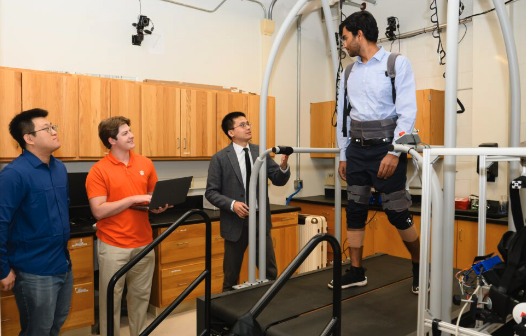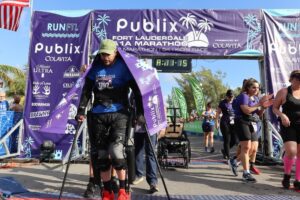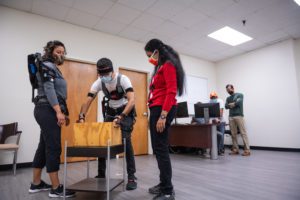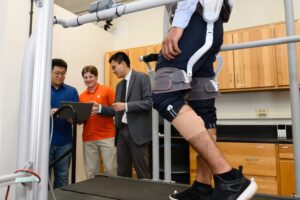Paralympics helps shine a light on exoskeleton research at Clemson University
September 9, 2024The work that Clemson University is doing to advance exoskeleton technology and make it available to a wide range of users is coming into sharp relief as Team USA goes for the gold in the Paris Paralympics.
Exoskeletons are devices worn outside the body to assist with movement. They come in a wide variety for the upper and lower body, some powered by batteries and motors, some by hydraulics and some by springs.

Leading Clemson’s exoskeleton research are two members of the industrial engineering faculty, Divya Srinivasan and Jessica Avilés, and a member of the mechanical engineering faculty, Ge Lv.

Adam Gorlinsky, founder of I Got Legs, is collaborating on exoskeleton research and has made it his goal to turn exoskeleton racing into a Paralympic and collegiate adaptive sport.
Avilés and Srinivasan are partnering on research with Greenville’s Adam Gorlitsky, an exoskeleton racer whose goal is to get the sport included in the Paralympics.
He holds world records for the fastest marathon and half-marathon in a robotic walking device and runs the nonprofit he founded, I Got Legs. Gorlitsky, who suffered a spinal cord injury in a 2005 car wreck, first came to prominence when he completed the 2016 Cooper River Bridge Run in under seven hours.
“My goal is to turn exoskeleton racing into a Paralympic and collegiate adaptive sport,” he said. “With the research, we can push that goal forward just a little bit.”

Jessica Avilés (left) and Divya Srinivasan (right) demonstrate their exoskeleton research with a student’s help.
The research aims to help people with spinal cord injuries find the best exoskeletons and training plans so they can participate in sports such as marathon racing. Avilés serves as the principal investigator, and their work is funded by Clemson’s Robert H. Brooks Sports Science Institute.
Avilés, an assistant professor, said the more time she spends with Gorlitsky, the more she sees how the technology can be improved.
“It can offer a lot for people who aren’t able to walk, and I still think we can do a lot with the technology– make it less clunky, more user friendly, lighter and more accessible,” she said.
Srinivasan, the McQueen Quattlebaum Professor of Industrial Engineering, said it’s uncommon to find someone with a spinal cord injury who can use an exoskeleton as well as Gorlitsky can. An expert user like him can talk through what is possible and what is not, sometimes saving years of work.
“In that sense, he’s really accelerating our research,” Srinivasan said.

Hamdan Khan wears an exoskeleton while walking on a treadmill in Ge Lv’s lab while Ph.D. student Miao Yu (far left) and undergraduate Tapp Rhoads (second from left) and Lv watch and discuss their research.
Lv, an assistant professor, said one of the big challenges with powered exoskeletons is getting them to adapt to each individual. It takes hours for a team of engineers and therapists to configure an exoskeleton’s control system for one person to execute a single type of movement, such as walking across a flat surface, he said.
Another type of movement, such as climbing steps, takes more time, Lv said.
The research he is leading with the support of a CAREER award from the National Science Foundation is aimed at helping exoskeletons adapt on their own.
“A key feature of this research is the ability to rapidly customize the exoskeleton, greatly reducing the time needed to tailor the device to an individual’s specific needs and tasks,” Lv said.
Photo credits: Clemson University


















